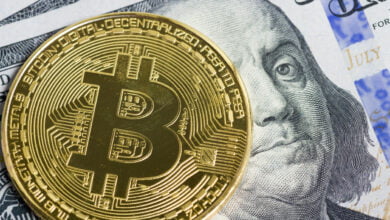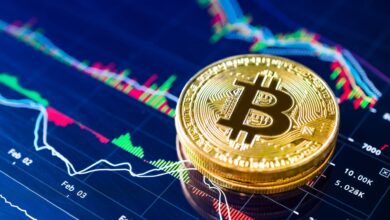
Table of Contents
In the rapidly evolving landscape of modern finance, traditional investment paradigms are continually challenged by the emergence of innovative assets. Among these, Bitcoin, the trailblazing cryptocurrency, and gold, the time-honored store of value, have emerged as two distinct yet captivating options for investors seeking to preserve and grow their wealth.
As global markets navigate unprecedented uncertainties and digital currencies reshape financial norms, the age-old debate intensifies: Should one place their faith in the timeless allure of gold, or embrace the digital revolution with Bitcoin? This article delves into the intricate nuances, historical contexts, and future prospects of these investment choices, shedding light on the factors that drive their appeal, the risks they entail, and the potential rewards they offer in an ever-evolving investment landscape.”
Comparing Investment Performance: Bitcoin vs. Gold
Investors have long sought after assets that can preserve and potentially increase their wealth over time. Two prominent contenders in the investment world are Bitcoin and gold. While they belong to vastly different categories, they share common attributes as alternative investments. This article delves into the investment performance of Bitcoin and gold, analyzing their historical trends, market dynamics, and potential benefits and drawbacks.
Historical Performance: Gold has been a store of value for centuries, maintaining its allure through economic downturns and geopolitical uncertainties. It has a well-established track record of retaining its worth over time. On the other hand, Bitcoin is a relatively newer asset, having emerged in 2009. Despite its short existence, Bitcoin has gained immense popularity due to its decentralized nature and potential as a digital store of value.
Market Dynamics: Gold’s value is influenced by various factors, including inflation, central bank policies, and market sentiment. It has a relatively stable market with a well-established trading infrastructure. Bitcoin, however, is known for its extreme price volatility, often experiencing rapid and substantial fluctuations. Its value is impacted by technological developments, regulatory changes, and market sentiment within the cryptocurrency ecosystem.
Benefits and Drawbacks: Gold is widely recognized as a hedge against economic uncertainties and a safe-haven asset. Its tangible nature and historical relevance make it a popular choice for conservative investors. Bitcoin, on the other hand, offers a decentralized and borderless alternative to traditional assets. Its scarcity, as well as its potential for high returns, attracts risk-tolerant investors seeking exposure to the digital economy.
While both assets have their merits, they also come with drawbacks. Gold’s price stability can lead to slower appreciation, and it may not offer the same growth potential as newer, high-risk assets like Bitcoin. Bitcoin’s volatility, while potentially rewarding, can also expose investors to significant losses.

Risk and Volatility: Assessing the Ups and Downs
Risk and volatility are inherent features of financial markets, and understanding their implications is crucial for investors aiming to make informed decisions. This article explores the concepts of risk and volatility, their impact on investment portfolios, and strategies to manage and leverage them effectively.
Risk vs. Volatility: Risk refers to the uncertainty of returns and the potential for loss. Volatility, on the other hand, measures the degree of price fluctuations over a specific period. While the two terms are related, they are distinct. High volatility often indicates increased risk, but not all risk is tied to volatility. Certain investments may be stable in the short term but carry significant long-term risks.
Investment Portfolios: Balancing risk and reward is a fundamental principle in portfolio management. Diversification, or spreading investments across different asset classes, can help mitigate risk. When constructing a portfolio, investors often combine assets with varying risk profiles. For instance, high-risk, high-reward assets like stocks may be complemented by more stable investments like bonds or precious metals.
Managing Volatility: Volatility can create opportunities for gains as well as losses. Active traders may capitalize on short-term price swings, while long-term investors could employ a “buy and hold” strategy to ride out market turbulence. Additionally, options such as stop-loss orders and hedging instruments can help limit potential losses during volatile periods.
Harnessing Risk for Growth: Certain investors actively seek risk and volatility as a means of achieving higher returns. They may allocate a portion of their portfolio to riskier assets, like emerging market stocks or innovative technologies. While this approach can yield substantial gains, it requires a thorough understanding of the associated risks and a higher risk tolerance.
Hedging Against Inflation: Bitcoin and Gold’s Role
Inflation, the steady increase in the general price level of goods and services, erodes the purchasing power of money over time. Investors often seek ways to protect their wealth from the corrosive effects of inflation. This article explores how Bitcoin and gold can serve as potential hedges against inflation, their historical performance during inflationary periods, and considerations for incorporating them into an investment strategy.
Gold as a Traditional Inflation Hedge: Gold has been a historical hedge against inflation for centuries. When the value of fiat currencies diminishes due to inflation, the intrinsic value of gold remains relatively stable. Investors flock to gold during inflationary periods, seeking a store of value that can preserve their purchasing power over time. Its scarcity, tangible nature, and universal recognition contribute to its appeal as an inflation hedge.
Bitcoin’s Emergence as a Digital Inflation Hedge: Bitcoin’s narrative as a digital gold and an inflation hedge has gained prominence in recent years. Like gold, Bitcoin’s scarcity is programmed into its protocol, with a fixed supply cap of 21 million coins. This scarcity, coupled with its decentralized nature and borderless accessibility, positions Bitcoin as a potential hedge against inflation and currency devaluation. However, Bitcoin’s relatively short existence and higher volatility compared to gold introduce additional considerations for investors.
Considerations for Investors: While both Bitcoin and gold offer potential protection against inflation, they come with distinct characteristics. Gold’s historical track record and stability make it a favored choice for conservative investors. Bitcoin, on the other hand, appeals to those seeking exposure to innovative digital assets and the potential for higher returns, albeit with greater risk.
Investors should carefully assess their risk tolerance, investment goals, and time horizon before incorporating Bitcoin or gold into their portfolios. Diversification strategies that combine both assets may provide a balanced approach to hedging against inflation, leveraging the unique attributes of each.
Also read: Aether Smart Contracts: Enabling Trustless Transactions
Market Accessibility and Liquidity: Bitcoin vs. Gold
In the modern financial landscape, investors have an array of options to choose from when it comes to assets for wealth preservation and potential appreciation. Two prominent contenders in this arena are Bitcoin and gold, each with its unique characteristics, advantages, and challenges. One crucial aspect that sets them apart is their market accessibility and liquidity.
Bitcoin’s Market Accessibility and Liquidity: Bitcoin, the pioneering cryptocurrency, has garnered significant attention due to its decentralized nature and potential for exponential growth. Its accessibility is primarily facilitated by the digital infrastructure, allowing investors to buy, sell, and trade Bitcoin across various cryptocurrency exchanges 24/7. This accessibility is further enhanced by the fractional ownership possibilities, enabling investors to buy small portions of a Bitcoin if the price is a barrier.
However, Bitcoin’s liquidity can be a double-edged sword. While its digital nature promotes rapid transactions, extreme price volatility is a concern. Sudden price fluctuations can lead to slippage during trades, impacting large transactions and potentially eroding gains.
Gold’s Market Accessibility and Liquidity: Gold, a tangible and time-tested asset, has been a store of value for centuries. Its accessibility is anchored in its global recognition and acceptance. Investors can buy physical gold, gold-backed exchange-traded funds (ETFs), or trade gold futures on commodities exchanges. Additionally, gold’s stability and universal recognition make it a preferred choice during times of economic uncertainty.
Gold’s liquidity is relatively stable, especially for smaller transactions. However, its physical nature can introduce delays and costs, particularly when dealing with large quantities. The lack of fractional ownership options also makes gold less accessible to those with limited resources.
Comparative Analysis: When comparing market accessibility and liquidity between Bitcoin and gold, it’s important to consider individual investment goals and risk tolerances. Bitcoin offers unparalleled accessibility due to its digital nature, but its high volatility demands cautious consideration. Gold, while less technologically advanced, maintains its status as a reliable asset with a long history of wealth preservation.
Investors seeking rapid trading and diversification might favor Bitcoin’s accessibility, whereas those prioritizing stability and a hedge against inflation could lean towards gold’s tangible nature.

Regulatory Considerations: Navigating Legal and Compliance Issues
The allure of investing in Bitcoin and gold extends beyond their potential returns. However, both assets operate within regulatory frameworks that investors must navigate. Understanding and complying with these regulations is crucial to ensure a smooth and lawful investment experience.
Bitcoin’s Regulatory Landscape: Bitcoin operates within a decentralized and often complex regulatory environment. Different countries have varying stances on its legality, classification, and taxation. Some nations embrace Bitcoin as a legitimate asset, while others have imposed restrictions or outright bans. Navigating this landscape requires investors to stay informed about local regulations, reporting requirements, and potential changes that could impact their holdings.
Gold’s Regulatory Landscape: Gold, being a traditional asset, is subject to well-established regulations, primarily centered around taxation, import/export, and anti-money laundering measures. The regulatory landscape for gold is generally more stable and predictable compared to the evolving environment of cryptocurrencies like Bitcoin.
Navigating Regulatory Challenges: To successfully navigate legal and compliance issues associated with Bitcoin and gold investments, investors should consider the following steps:
- Educate Yourself: Stay informed about the regulatory status of both assets in your jurisdiction and any relevant international regulations.
- Consult Experts: Seek advice from legal and financial professionals well-versed in cryptocurrency and precious metals regulations.
- Tax Implications: Understand how gains, losses, and transactions are taxed for each asset and ensure accurate reporting.
- Security Measures: Comply with security protocols to protect your assets and personal information, considering the unique cybersecurity risks associated with cryptocurrencies.
- Regular Updates: Regulations around these assets can change rapidly. Stay up-to-date with regulatory developments to ensure ongoing compliance.
Diversification Strategies: Combining Bitcoin and Gold in a Portfolio
Diversification is a cornerstone of prudent investment, and combining assets with different risk profiles can enhance a portfolio’s stability and potential returns. Integrating Bitcoin and gold into a single investment strategy can offer a compelling balance between modern digital opportunities and traditional wealth preservation.
Balancing Risk and Reward: Bitcoin and gold offer distinct risk-reward profiles. Bitcoin’s potential for high growth is accompanied by its notorious volatility, while gold’s stability can act as a hedge against economic uncertainties. By strategically allocating a portion of a portfolio to both assets, investors can mitigate risks and tap into potential rewards.
Correlation and Hedging: The low historical correlation between Bitcoin and gold makes them attractive candidates for portfolio diversification. When one asset experiences volatility or underperformance, the other may respond differently, potentially offsetting losses. This correlation dynamic can enhance risk management and provide a smoother investment experience.
Allocation Strategies: Investors have several approaches to incorporating Bitcoin and gold into their portfolios:
- Equal Weight Allocation: Allocating an equal percentage of the portfolio to both assets, ensuring a balanced exposure to their respective qualities.
- Risk-Based Allocation: Tailoring the allocation based on individual risk tolerance and investment goals. More risk-averse investors may allocate a larger portion to gold, while those seeking higher growth potential may tilt towards Bitcoin.
- Tactical Rebalancing: Regularly reviewing and adjusting the portfolio’s allocation based on market conditions and performance.
- Long-Term Perspective: Emphasizing a long-term perspective to benefit from potential appreciation while weathering short-term volatility.
Monitoring and Adjusting: Portfolio diversification is not a one-time action; it requires ongoing monitoring and adjustments. Periodic evaluations of the performance of Bitcoin and gold relative to other holdings will help ensure that the portfolio remains aligned with the investor’s goals.
Also read: Exploring the Potential of Aether: Decentralized Finance and Beyond
FAQS
Q: What is Bitcoin?
A: Bitcoin is a digital cryptocurrency that operates on a decentralized network using blockchain technology.
Q: What is gold?
A: Gold is a precious metal that has been used for centuries as a store of value and a medium of exchange.
Q: What are the potential returns of investing in Bitcoin?
A: Bitcoin has shown the potential for high returns over a short period, but its value is known to be volatile.
Q: How does gold typically perform as an investment?
A: Gold is often considered a relatively stable investment, with moderate and steady returns over time.
Q: What factors influence the value of Bitcoin?
A: The value of Bitcoin can be influenced by factors such as market demand, adoption, regulatory changes, and macroeconomic trends.
Q: What factors affect the value of gold?
A: The value of gold can be influenced by factors like inflation, economic stability, central bank policies, and geopolitical events.
Q: Is Bitcoin considered a safe investment?
A: Bitcoin is considered a higher risk investment due to its price volatility and relative newness in the financial markets.
Q: Is gold considered a safe investment?
A: Gold is often seen as a safe-haven asset, especially during times of economic uncertainty and market turbulence.
Q: How accessible are Bitcoin and gold as investments?
A: Bitcoin can be easily bought and sold through cryptocurrency exchanges, while gold can be bought through dealers, banks, and investment products.
Q: Which investment is more liquid, Bitcoin or gold?
A: Bitcoin generally offers quicker and more global liquidity, but gold also has a well-established liquid market.
Q: Are there storage considerations for these investments?
A: Bitcoin is stored electronically in digital wallets, while gold requires physical storage which may incur additional costs.
Q: Are there any regulatory concerns with Bitcoin and gold?
A: Bitcoin’s regulatory environment is evolving and can vary by jurisdiction. Gold is subject to regulations related to trading, storage, and ownership.
Q: Can I diversify my portfolio with Bitcoin and gold?
A: Yes, investing in both Bitcoin and gold can offer diversification benefits, as they may respond differently to various market conditions.
Q: Which investment is more suitable for long-term growth?
A: Both Bitcoin and gold have potential for long-term growth, but their performance depends on various economic and technological factors.
Q: What role does each investment play in a balanced portfolio?
A: Bitcoin can add potential for higher returns and diversification, while gold can provide stability and act as a hedge against economic downturns.
Q: Ultimately, which is a better investment, Bitcoin or gold?
A: There’s no definitive answer, as the choice between Bitcoin and gold depends on individual risk tolerance, investment goals, and market outlook. It’s advisable to consult with financial experts before making a decision.




